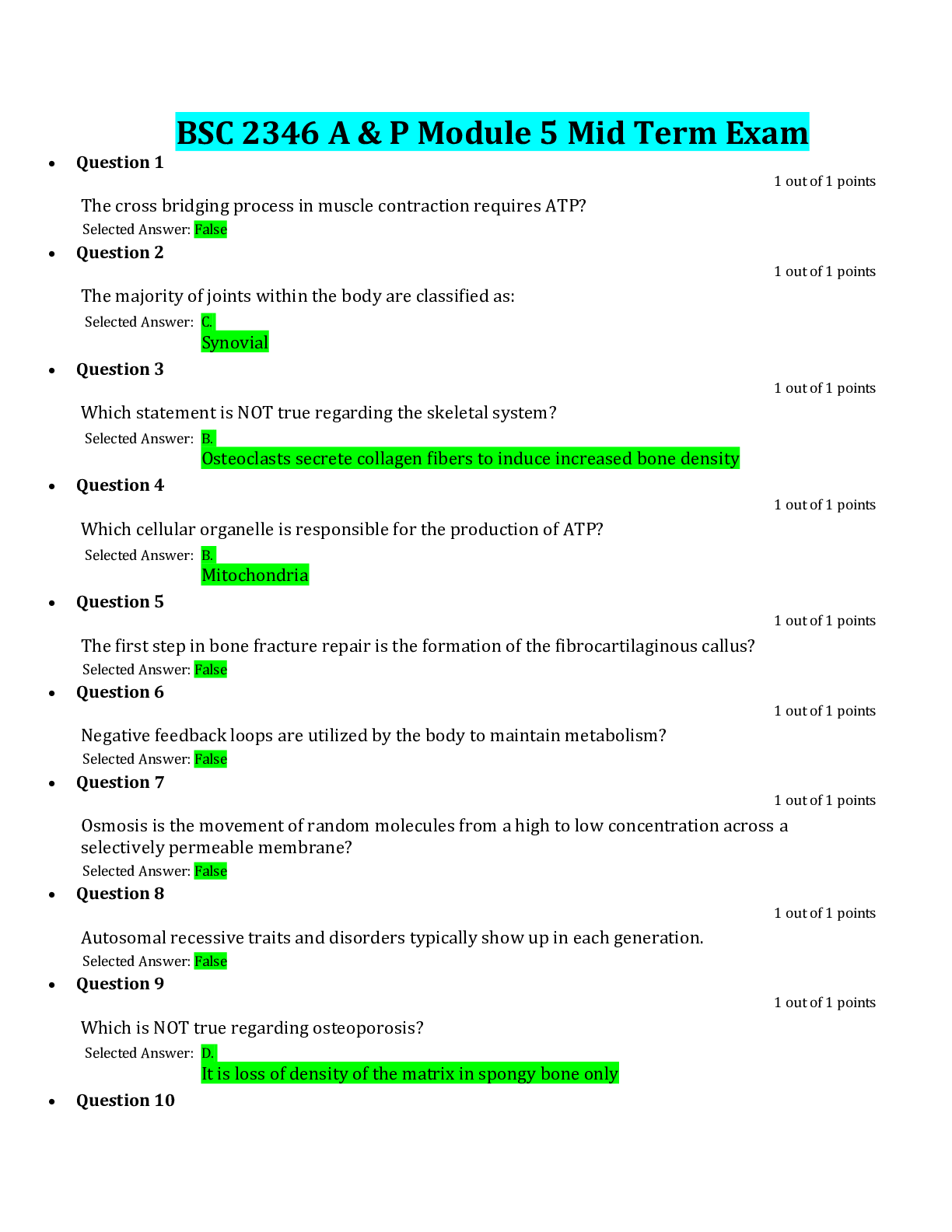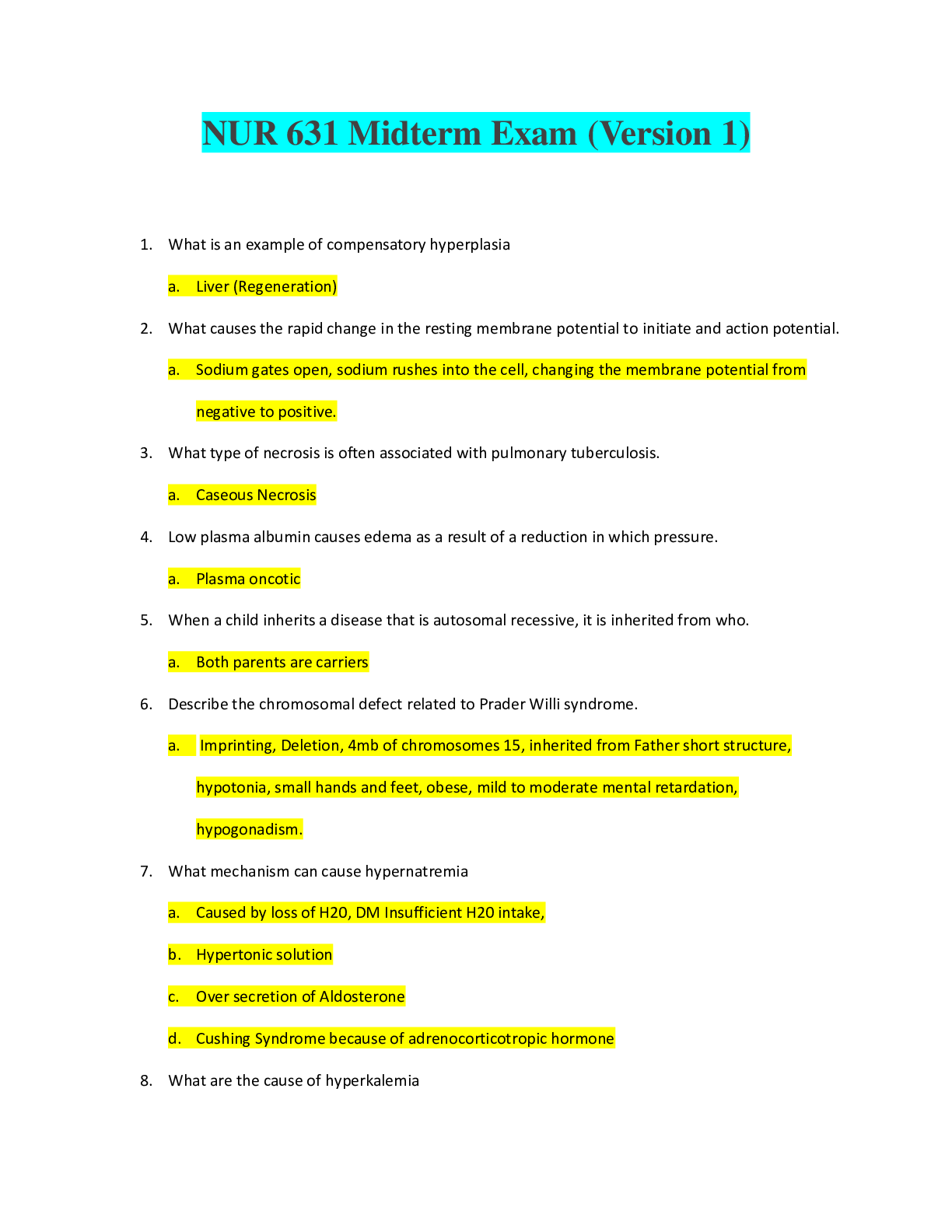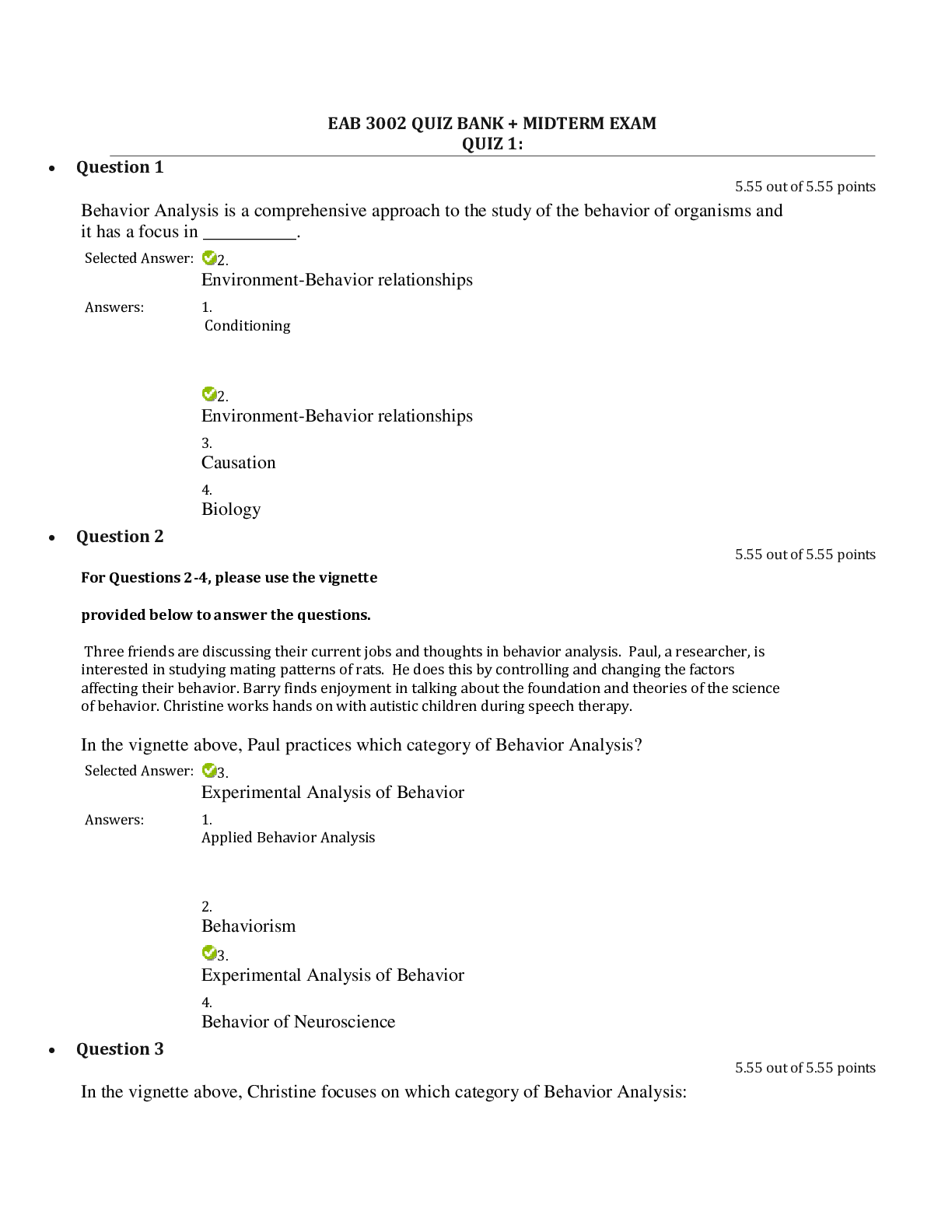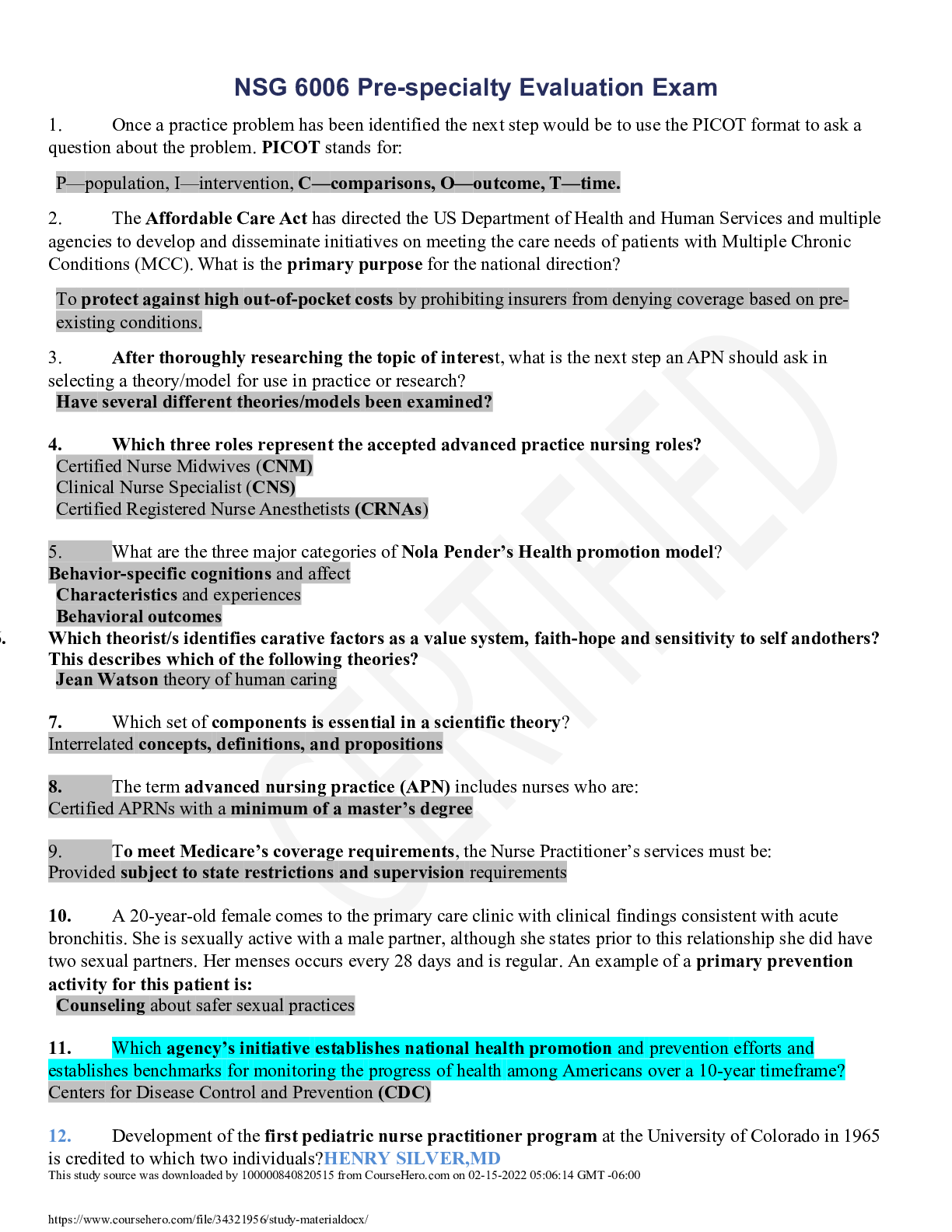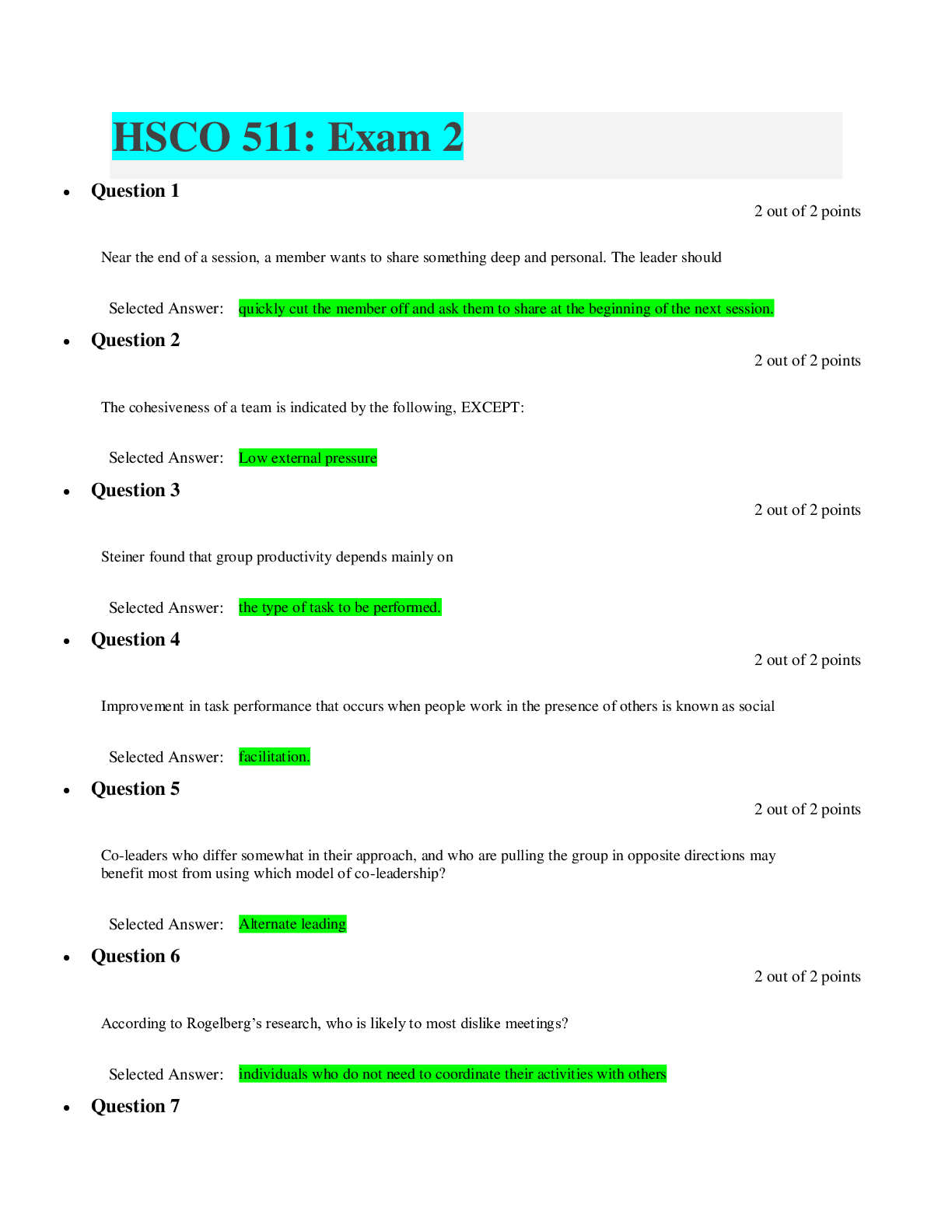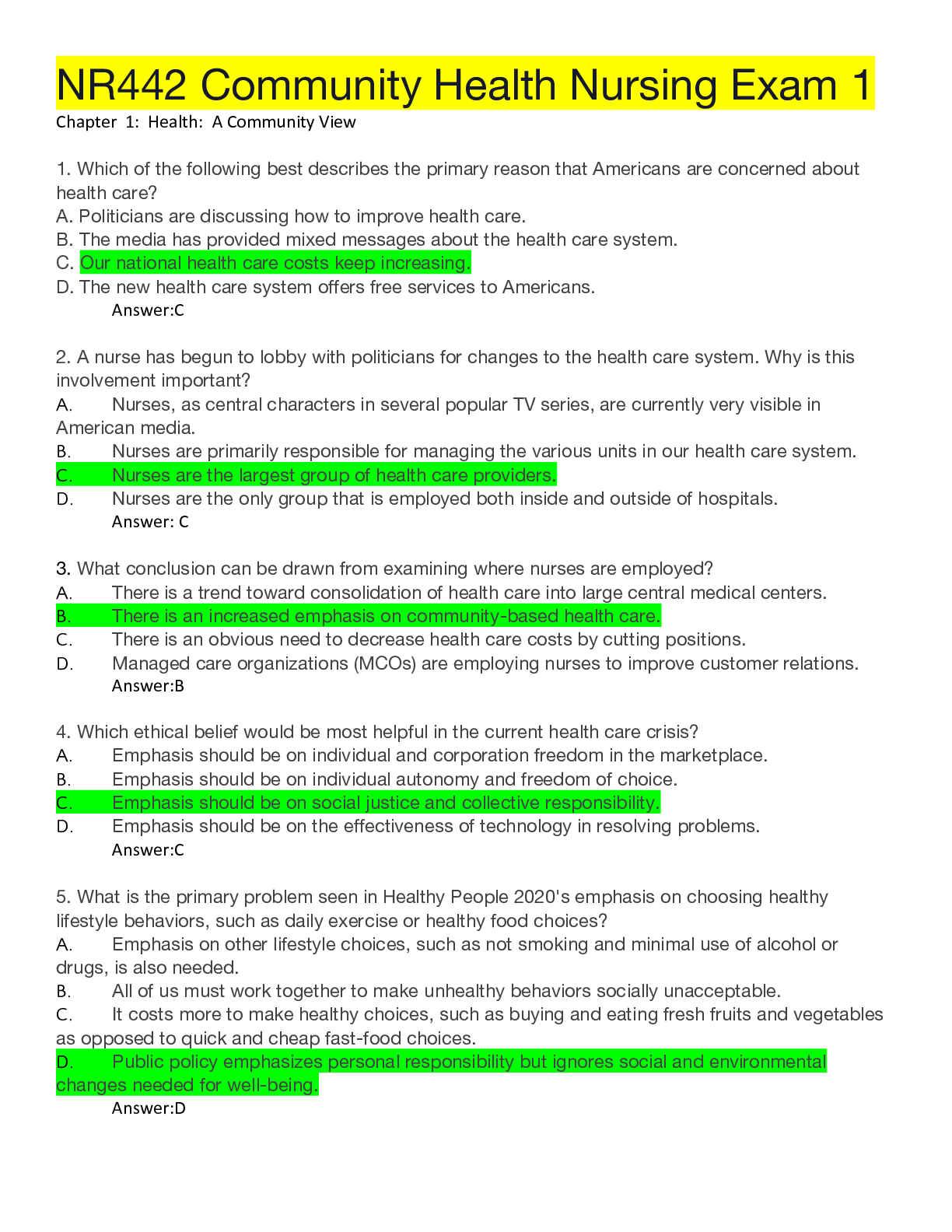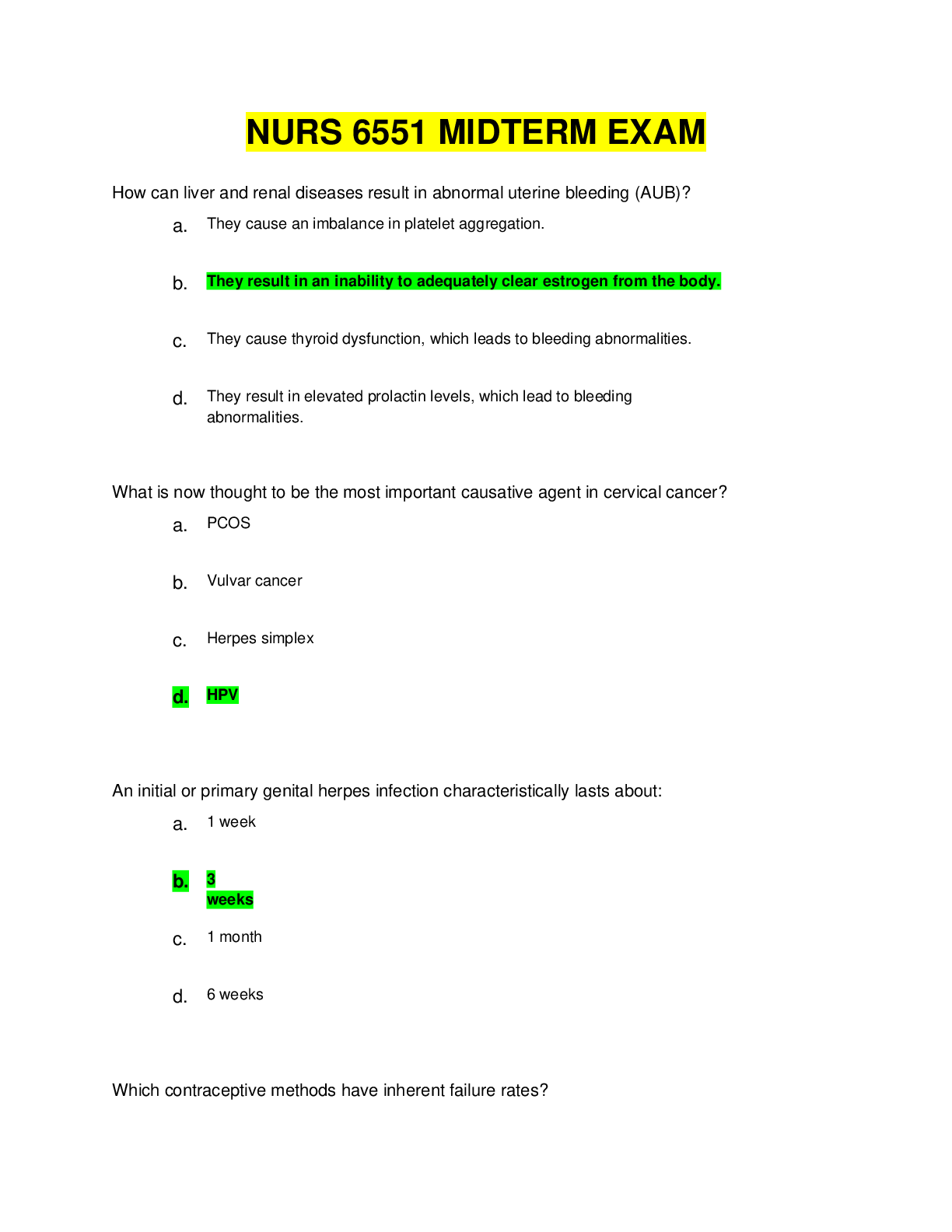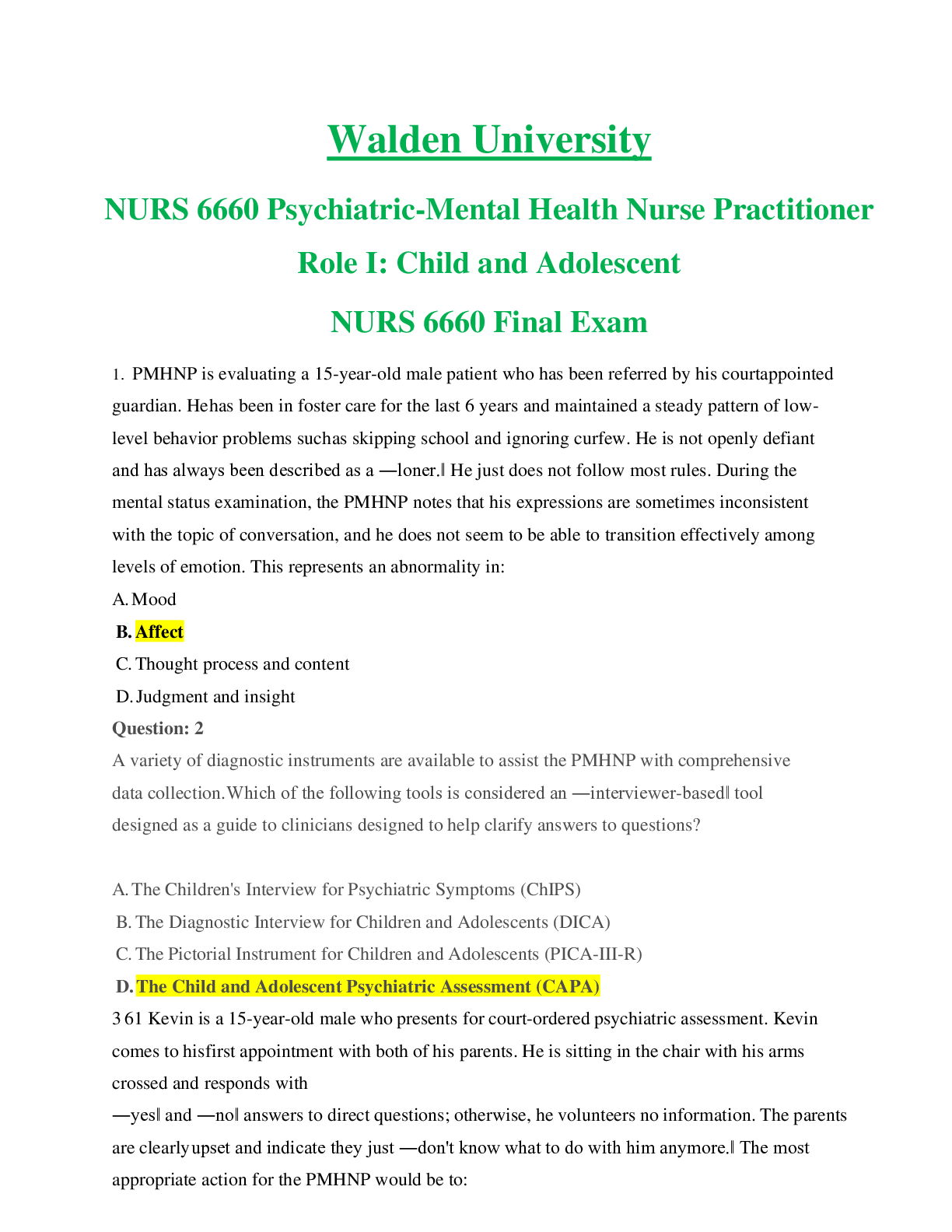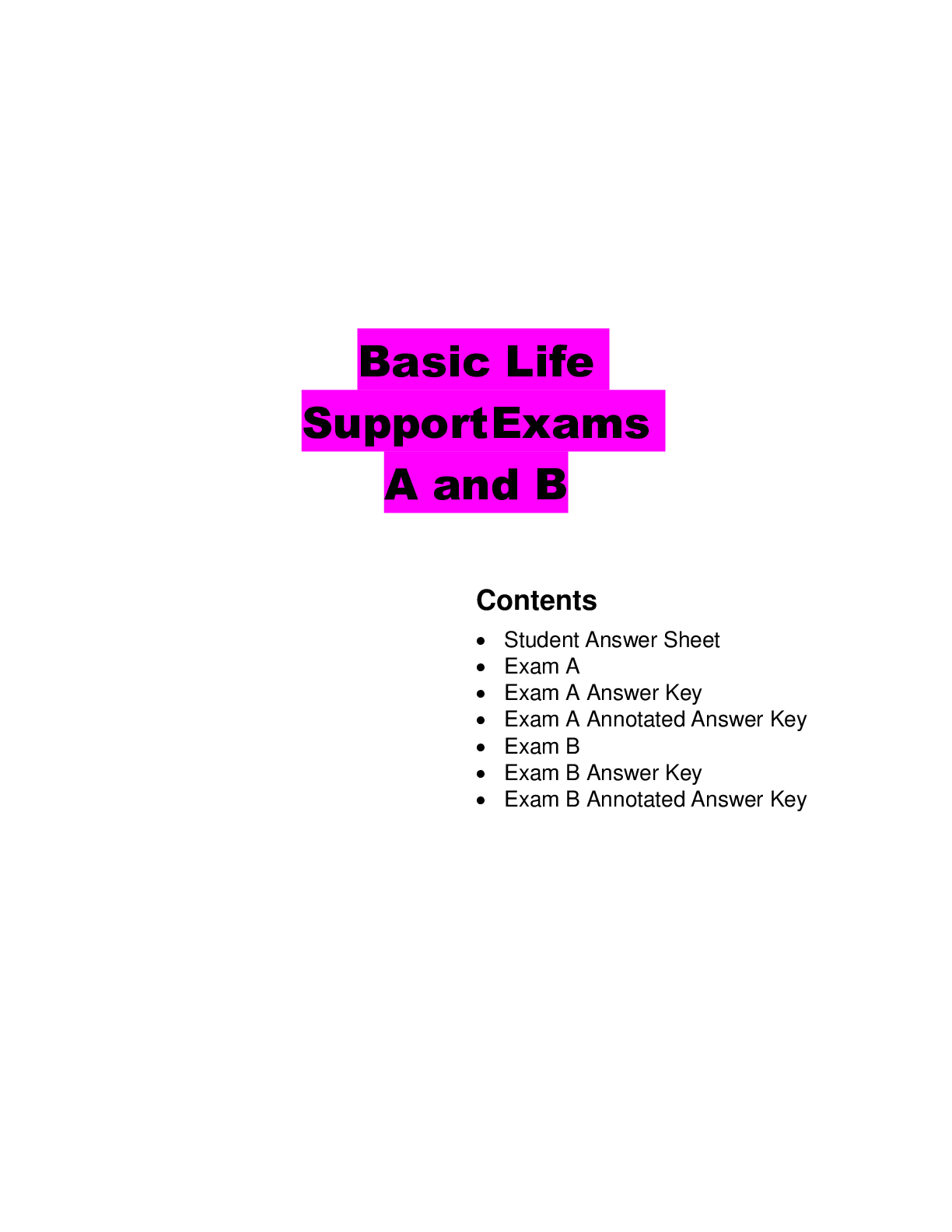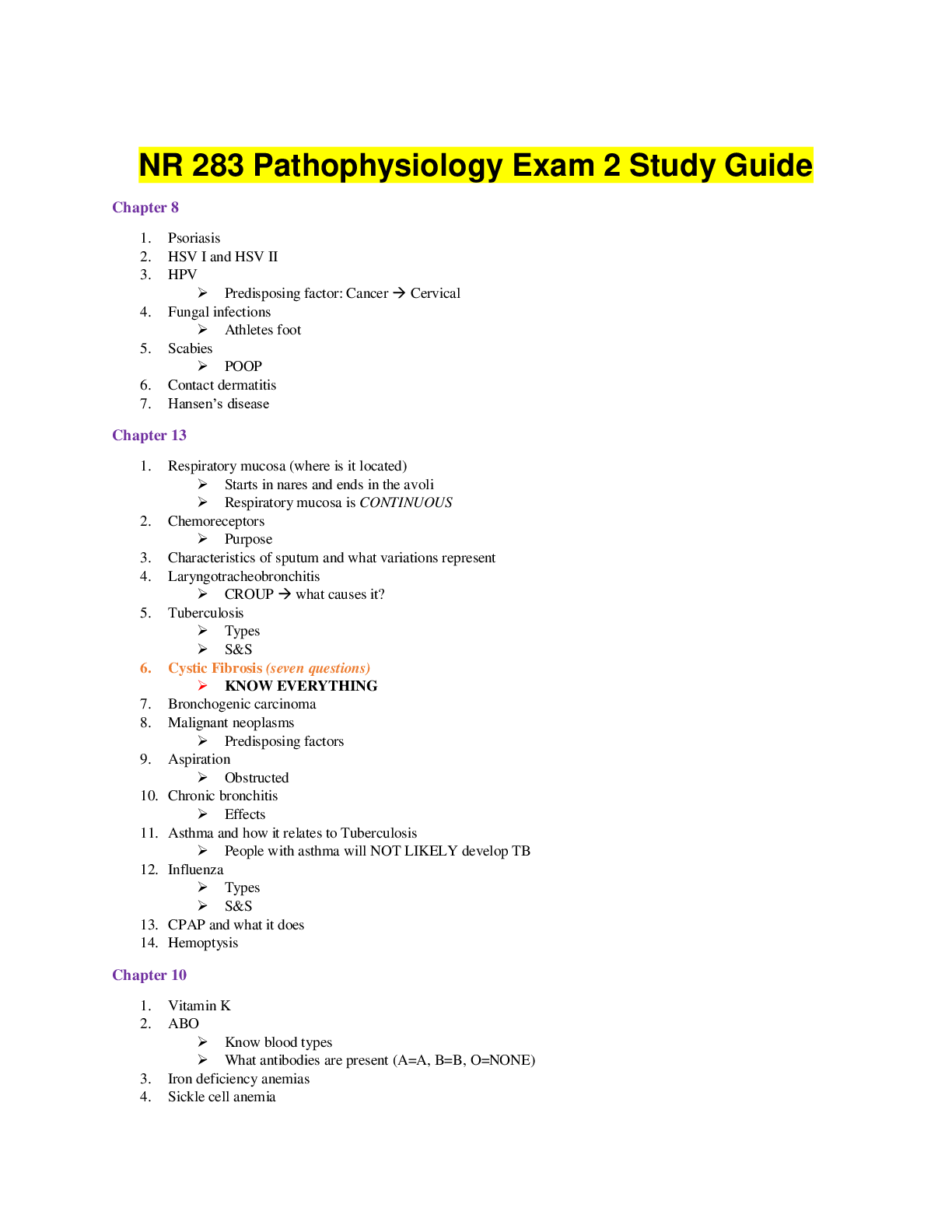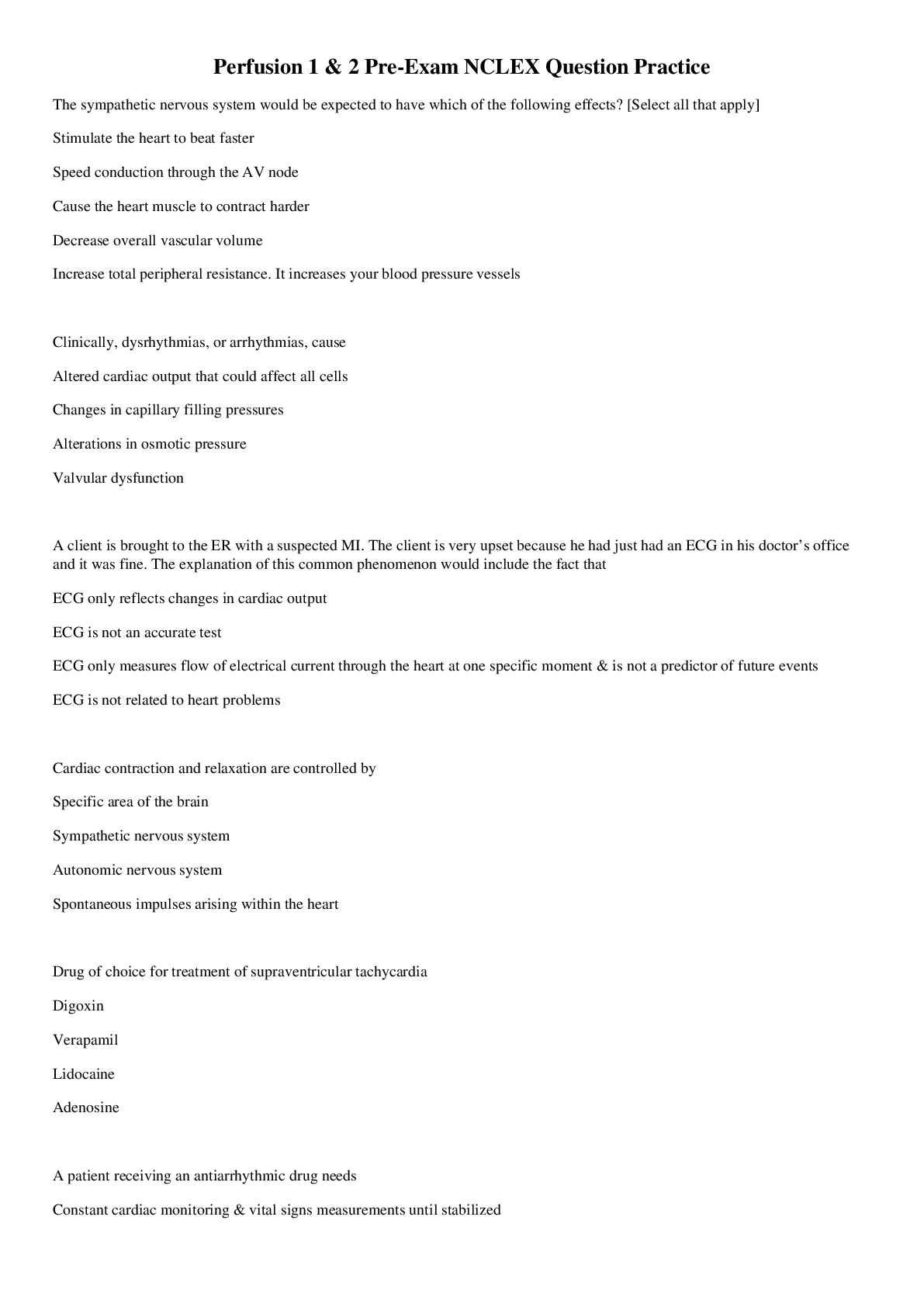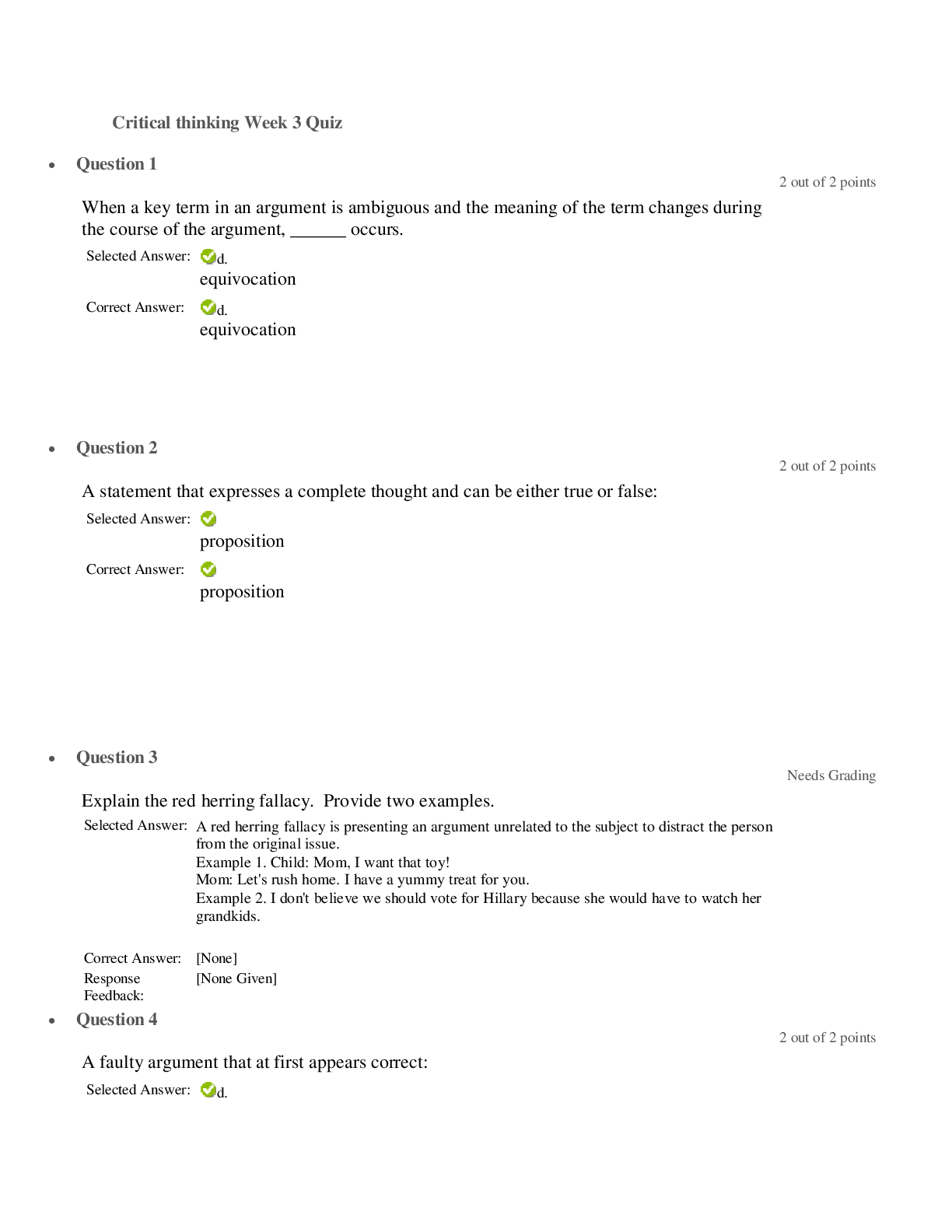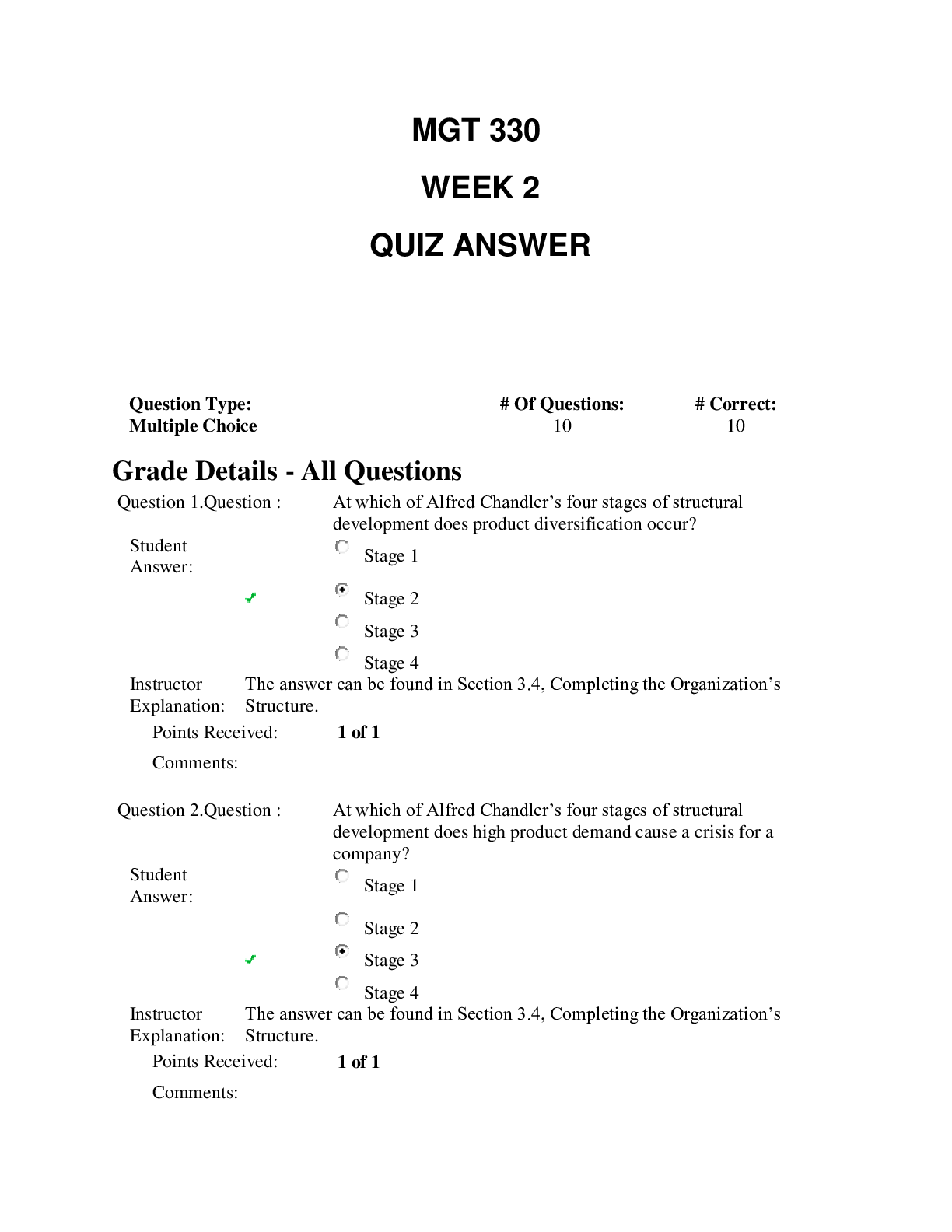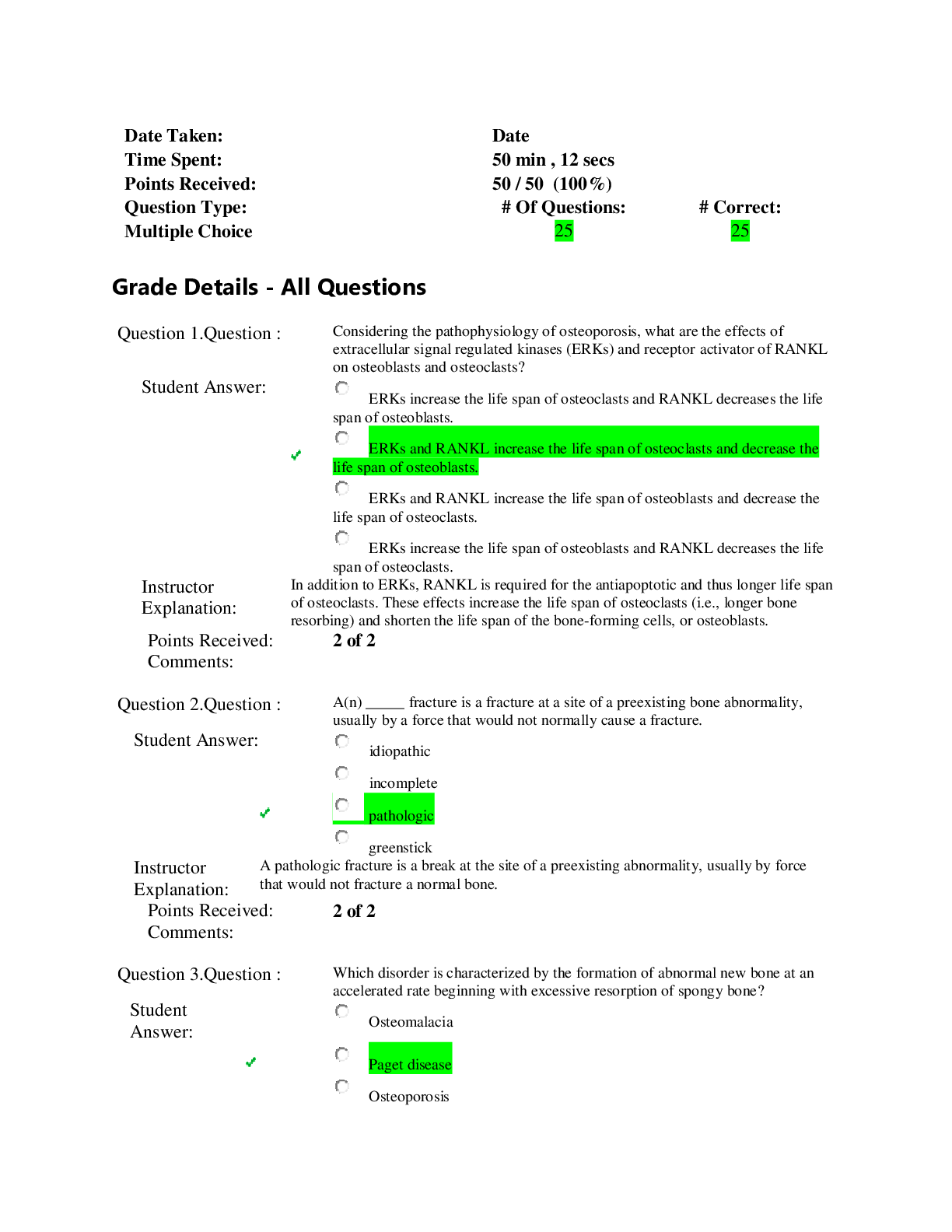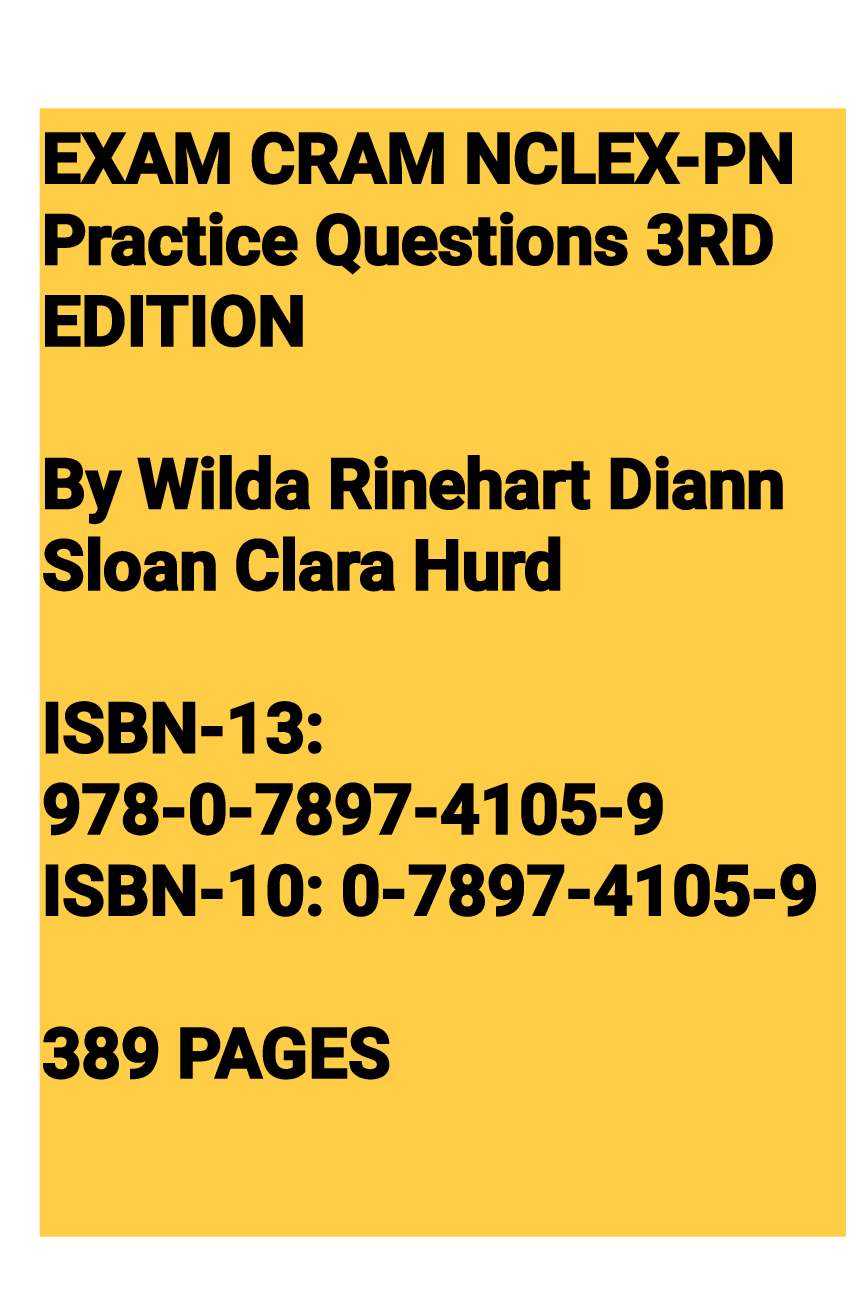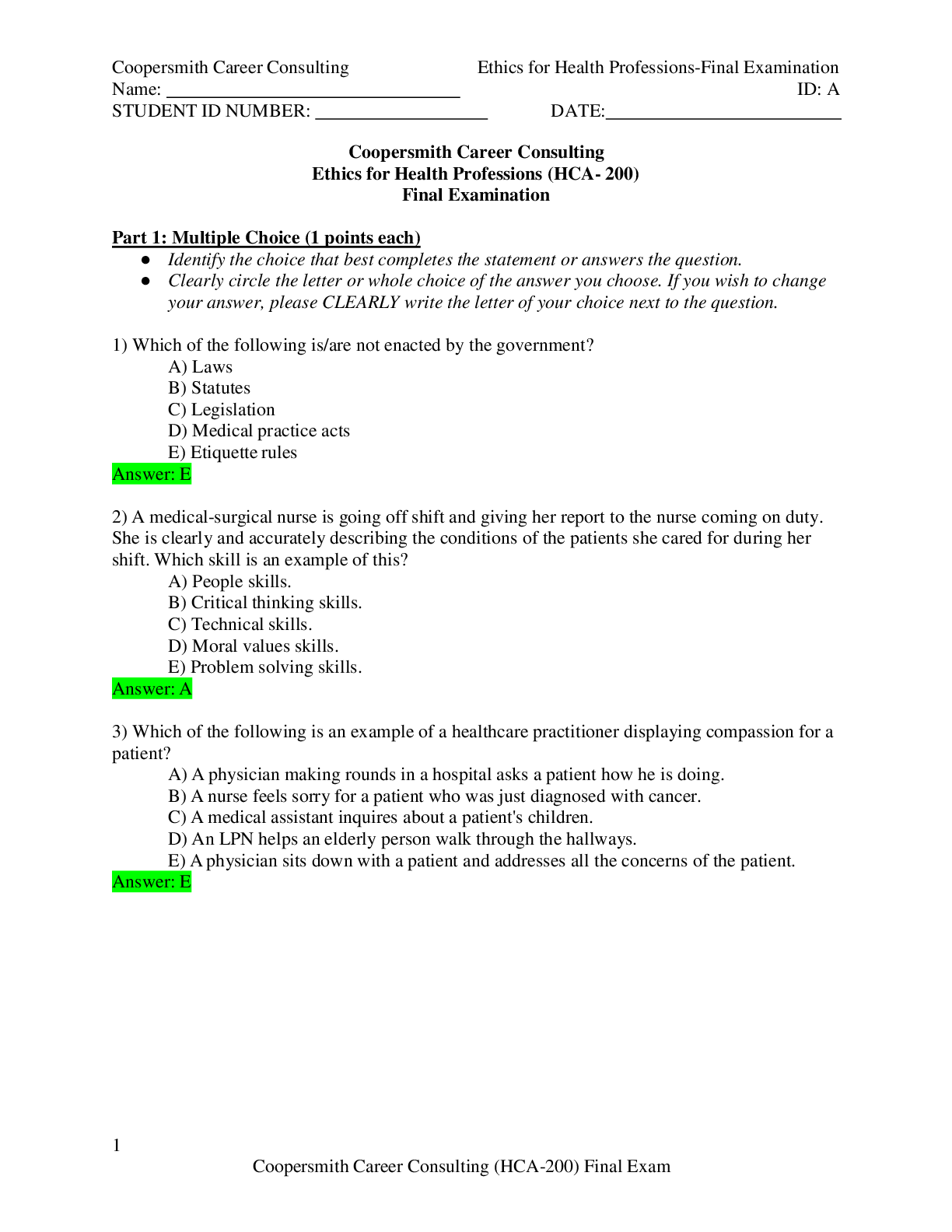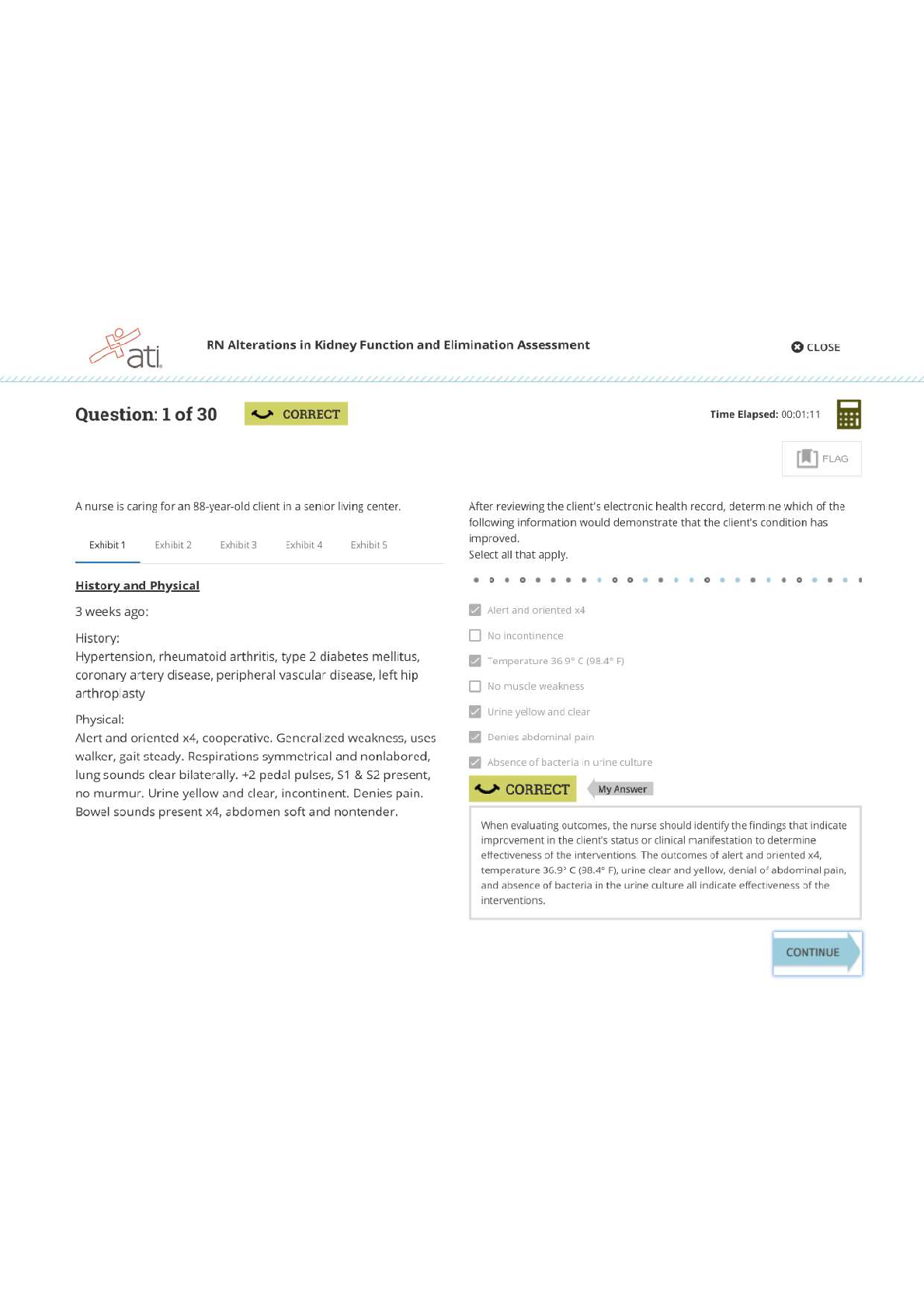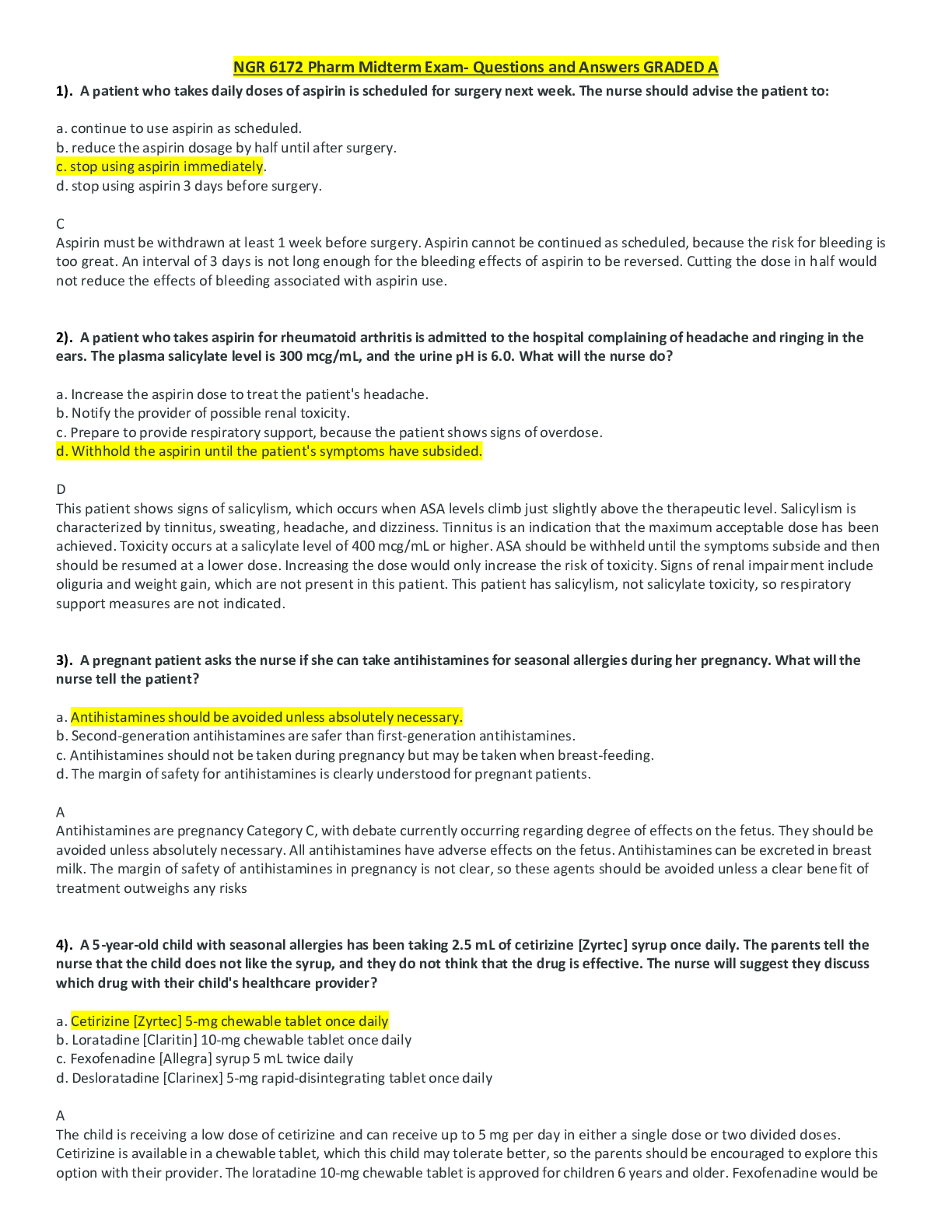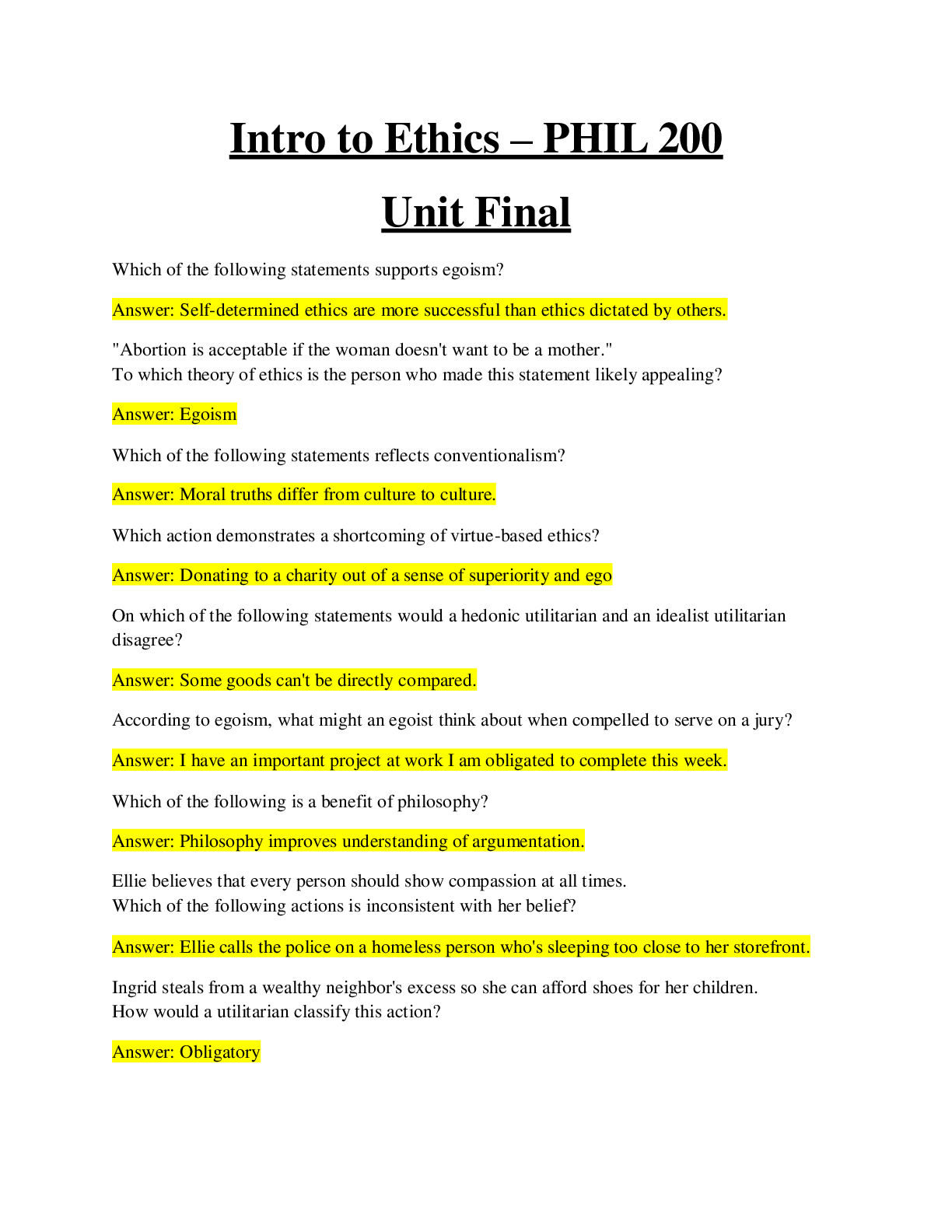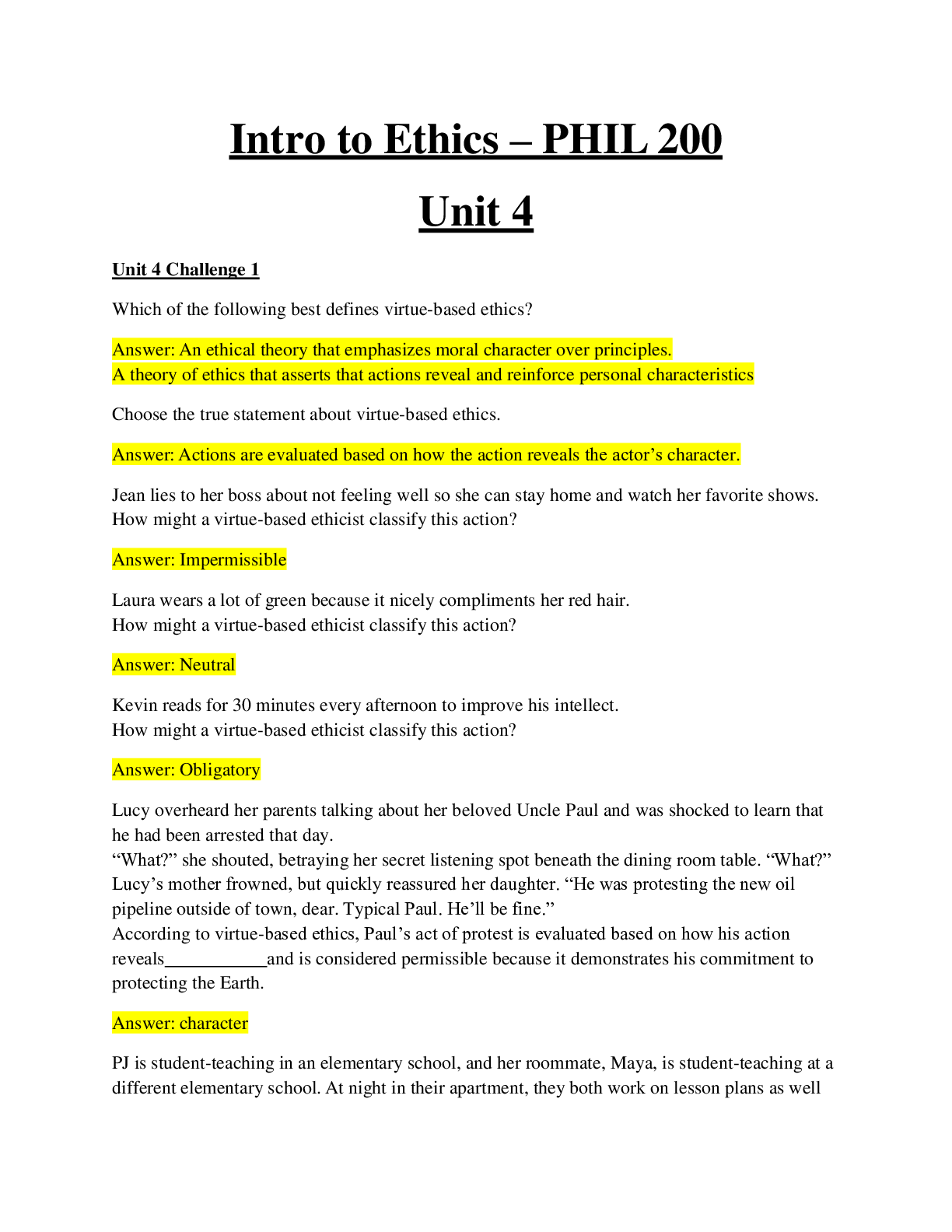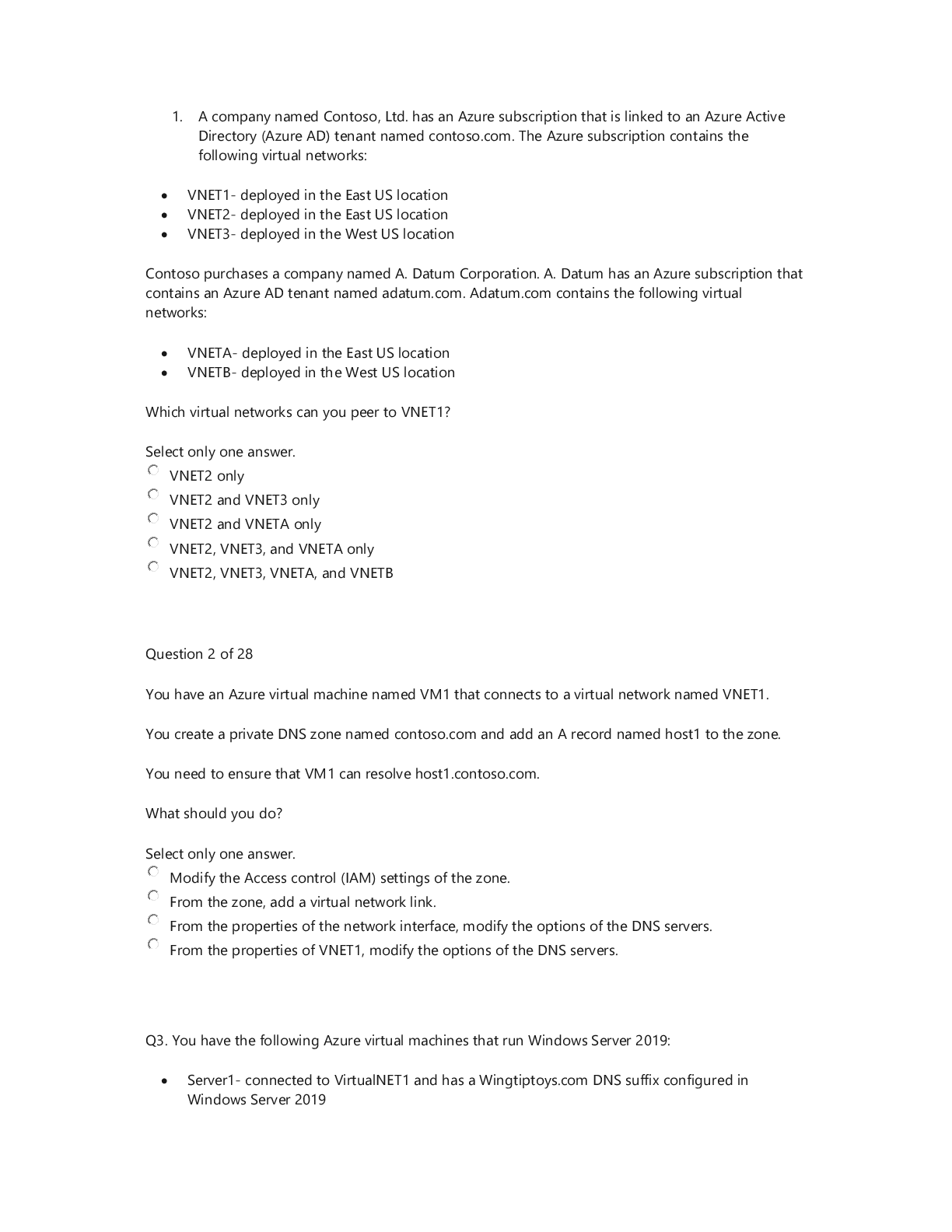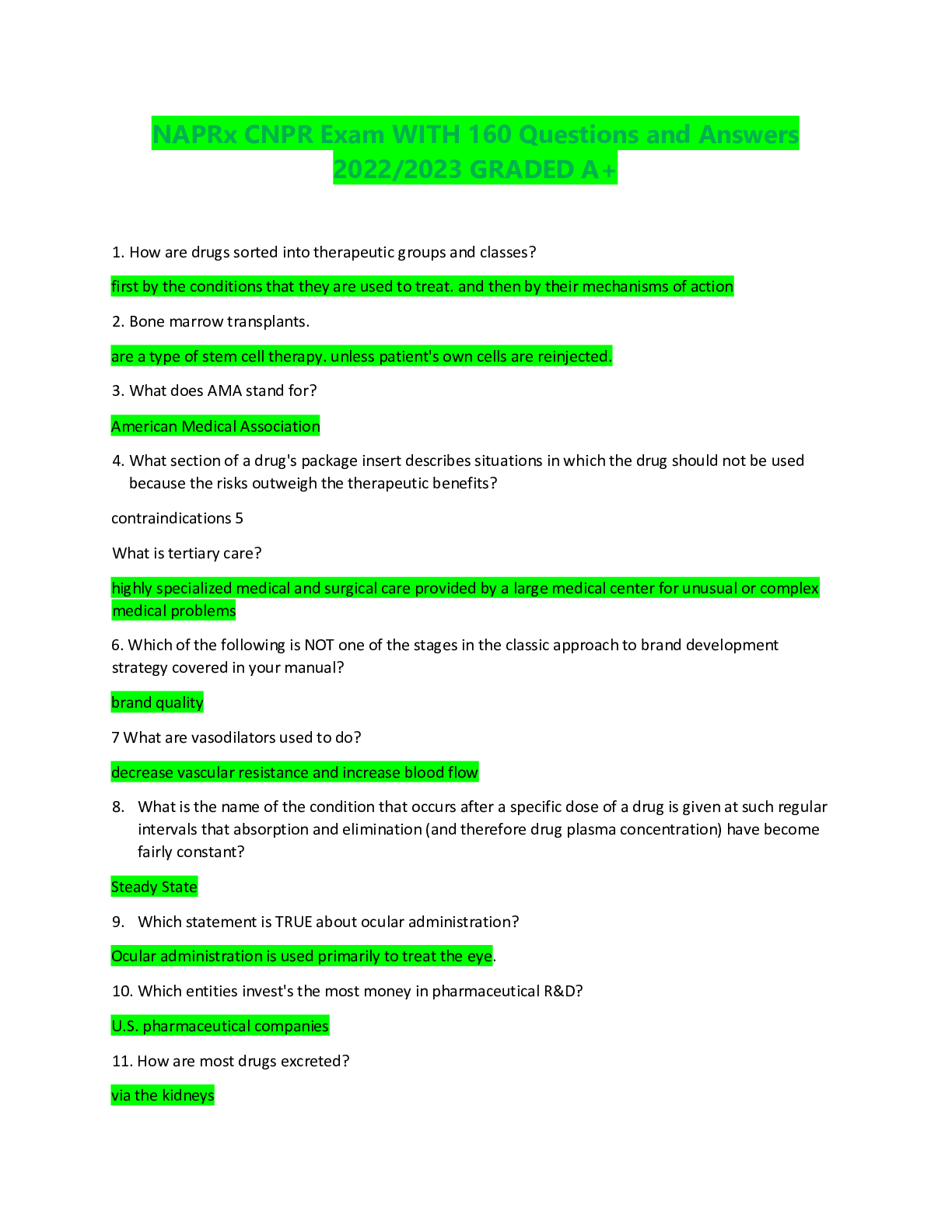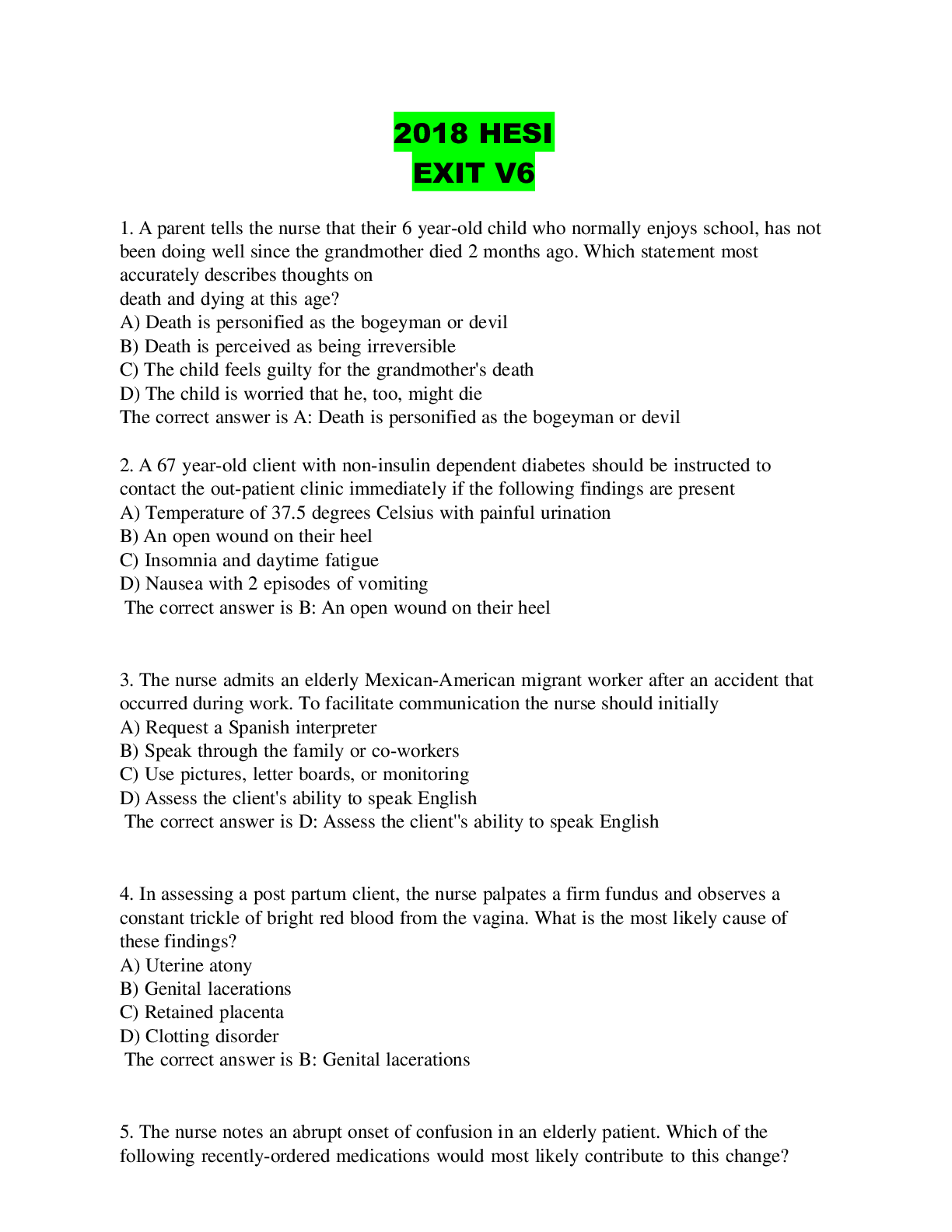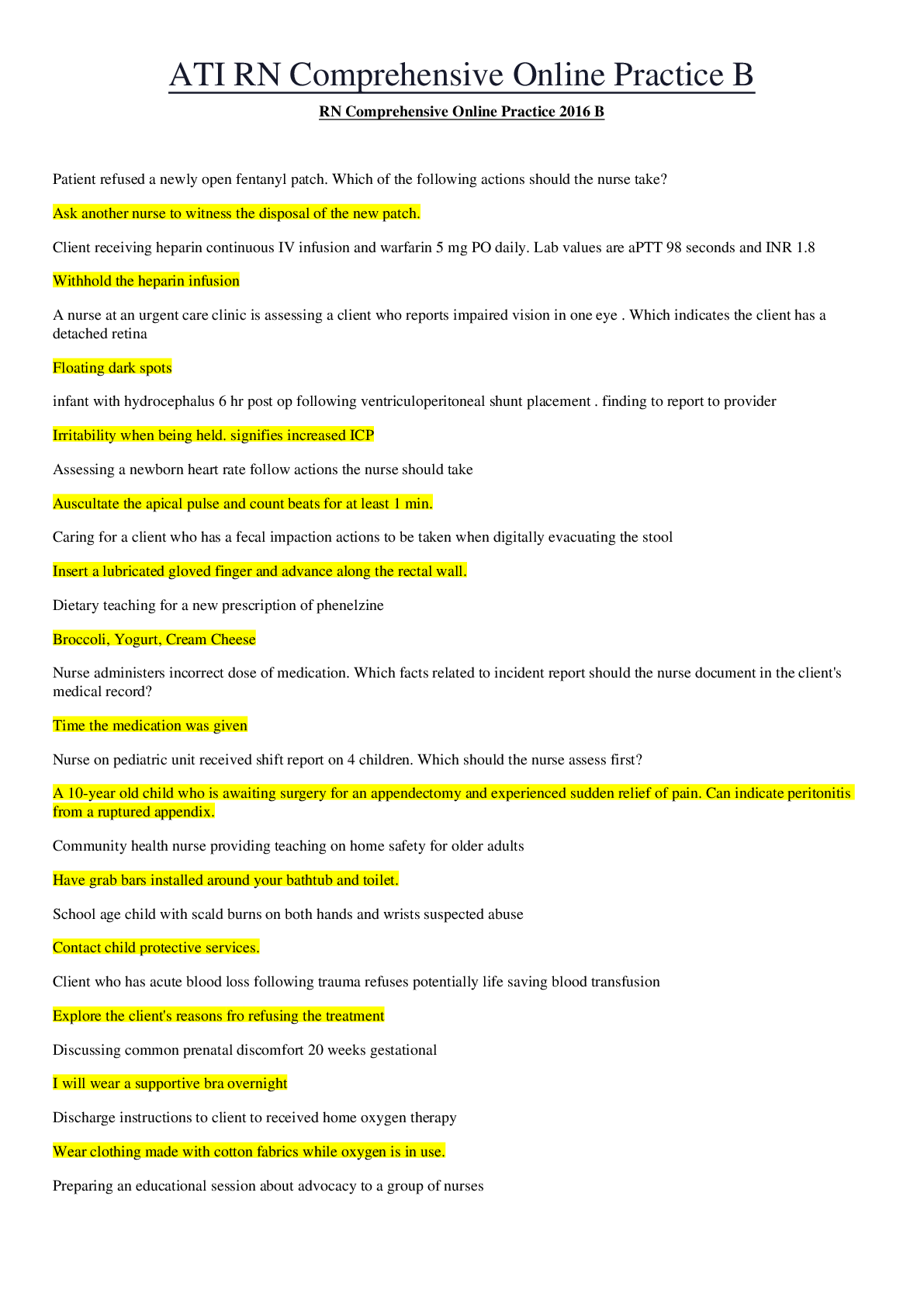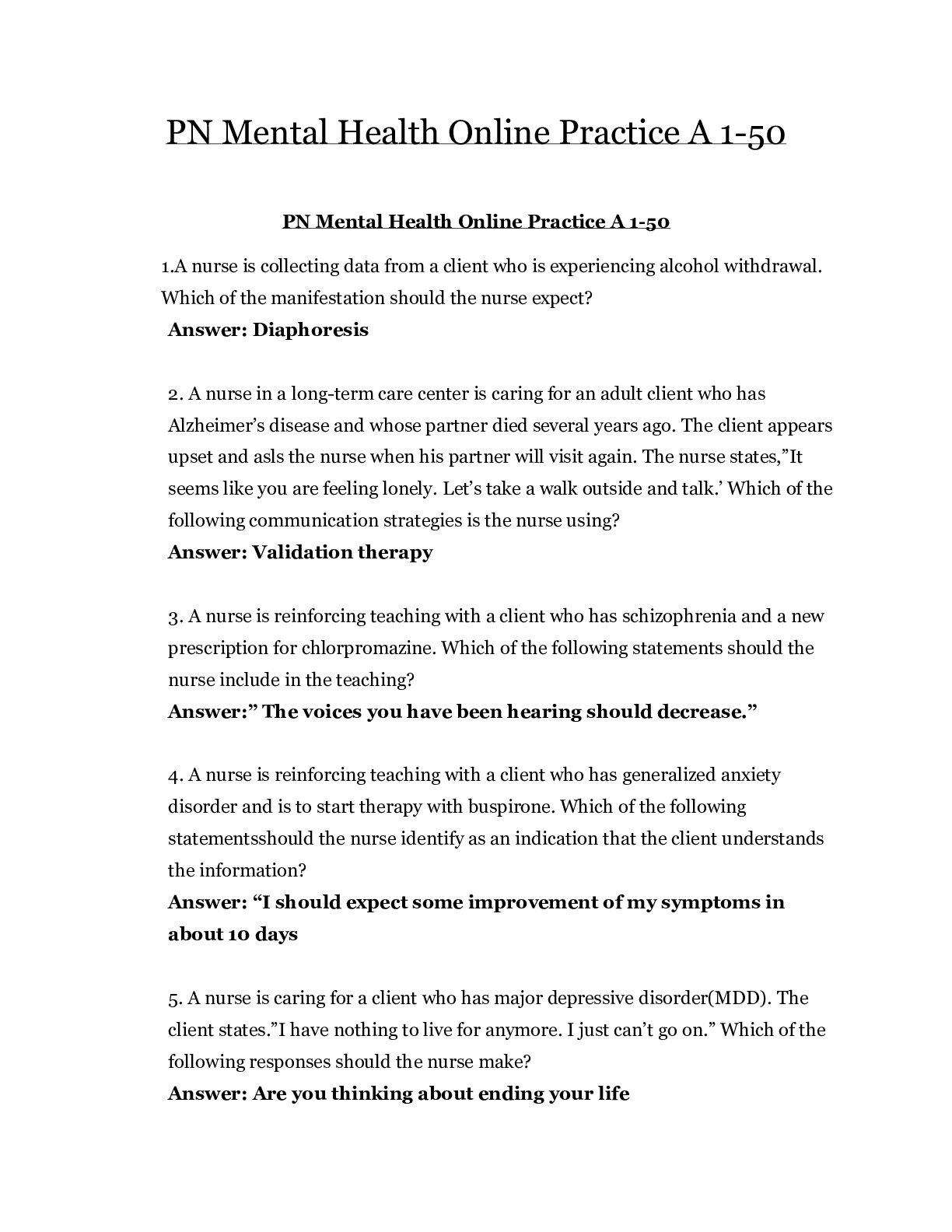NSG 6310-Exam 2- Cedarville University-Latest-Attempt Score 100%
Document Content and Description Below
NSG 6310 exam 2 –Attempt score 100% A patient who is on renal dialysis is diagnosed with infective endocarditis. What causative organisms are more likely in this patient? a. Staphylococcus aureus ... b. Enterococcal organisms c. Pseudomonas aeruginosa d. Neisseria gonorrhea According to current research, which are associated with a decreased incidence of stroke? (Select all that apply.) a. ≧7 servings of fruits and vegetables per day b. B-complex vitamin supplements c. Intensive insulin therapy in type 1 diabetes d. Low-sugar soda e. Mediterranean diet A patient has native valve endocarditis. While blood cultures are pending, which antibiotics will be ordered as empiric treatment? a. Vancomycin and quinupristin-dalfopristin b. A beta-lactamase resistant penicillin and an antifungal drug c. Penicillin and an aminoglycoside antibiotic d. Imipenem-cilastin and ampicillin Term An asymptomatic 63-year-old female has a low-density lipoprotein level of 135 mg/dL. Which test is beneficial to assess this patient’s coronary artery disease risk? a. Exercise echocardiography b. C-reactive protein c. Coronary artery calcium score d. Myocardial perfusion imaging An elderly female without prior history of cardiovascular disease reports lower leg soreness and fatigue when shopping or walking in the neighborhood. The primary care provider notes decreased pedal pulses bilaterally. Which test will the provider order initially to evaluate for peripheral arterial disease based on these symptoms? a. Digital subtraction angiography b. Doppler ankle, arm index c. Segmental limb pressure measurement d. Magnetic resonance angiography A patient is diagnosed with PAD and elects not to have angioplasty after an angiogram reveals partial obstruction in lower extremity arteries. What will the provider recommend to help with relief of symptoms in this patient? a. Walking to the point of pain each day b. Statin therapy with clopidogrel c. Daily aspirin therapy to prevent clotting d. Walking slowly for 15 to 20 minutes twice daily Term A patient has a cardiac murmur that peaks in midsystole and is best heard along the left sternal border. The provider determines that the murmur decreases in intensity when the patient changes from standing to squatting and increases in intensity with the Valsalva maneuver. Which cause will the provider suspect for this murmur? a. Mitral valve prolapse b. Aortic stenosis c. Hypertrophic cardiomyopathy d. Tricuspid regurgitation Ter A patient has infective endocarditis and is being treated with empiric antibiotics after blood cultures are inconclusive. The patient develops a severe headache along with transient neurologic changes. What is the likely cause of these symptoms? a. Rheumatic heart fever b. Extra-cardiac abscess formation c. Mycotic aneurysm d. Haemophilus infection Term A child with a history of asthma is brought to the clinic with a rapid heart rate. A cardiac monitor shows a heart rate of 225 beats per minute. The provider notifies transport to take the child to the emergency department. What initial intervention may be attempted in the clinic? a. Giving a beta blocker b. Using a vagal maneuver or carotid massage c. Providing a loading dose of digoxin d. Administration of intravenous adenosine Ter A patient who is a runner is diagnosed with viral myocarditis and asks when he may begin exercising again. What will the provider tell this patient? a. Exercise is contraindicated for life b. Exercise may resume when symptoms subside c. He must be symptom-free for 1 year d. He may resume exercise in 6 months An adult patient reports frequent episodes of syncope and lightheadedness. The provider notes a heart rate of 70 beats per minutes. What will the provider do next? a. Monitor the patient’s heart rate while the patient is bearing down b. Evaluate the patient’s orthostatic vital signs c. Reassure the patient that the symptoms are non-cardiac in origin d. Order an electrocardiogram and exercise stress test Term A patient reports abdominal and back pain with anorexia and nausea. During an exam, the provider notes a pulsatile abdominal mass. What is the initial action? a. Scheduling an MRI to evaluate for aortic disease b. Ultrasound of the mass to determine size c. Immediate referral to a thoracic surgeon d. Ordering computerized tomography angiography A young female patient has known mitral valve prolapse. During a routine health maintenance exam, the provider notes an apical systolic murmur and a midsystolic click on auscultation. The patient denies chest pain, syncope, or palpitations. What will the provider do? a. Admit the patient to the hospital for evaluation and treatment b. Consult with the cardiologist to determine appropriate diagnostic tests c. Continue to monitor the patient every 3 years d. Reassure the patient that these findings are expected During a routine health maintenance examination, the provider auscultates a cervical bruit. The patient denies syncope, weakness, or headache. What will the provider do, based on this finding? a. Order a carotid duplex ultrasound b. Order catheter-based angiography c. Refer the patient to a neurosurgeon d. Schedule a computed tomography angiography A 75-year-old patient reports pain and a feeling of tiredness in both legs that only relieves after sitting for 30 minutes or more. What the does provider suspect as the cause for these symptoms? a. Peripheral arterial disease b. Buerger’s disease c. Cauda equina syndrome d. Diabetic neuropathy Term A patient who has heart failure with reduced ejection fraction will have which symptoms? a. Impairment of ventricular filling and relaxation b. Mild, exertionally related dyspnea c. Pump failure from left ventricular systolic dysfunction d. Dyspnea and fatigue without volume overload A patient reports recurrent chest pain that occurs regardless of activity and is not relieved by rest. The provider administers a nitroglycerin tablet which does not relieve the discomfort. What is the next action? a. Administer a second nitroglycerin tablet b. Give the patient a beta blocker medication c. Prescribe a calcium channel blocker mediation d. Start aspirin therapy and refer the patient to a cardiologist m A patient reports sustained, irregular heart palpitations. What is the most likely cause of these symptoms? a. Extrasystole b. Atrial fibrillation c. Paroxysmal attacks d. Anemia Which test is diagnostic for diagnosing myocarditis? a. Magnetic resonance imaging b. Electrocardiogram c. Echocardiogram d. Endomyocardial biopsy An African-American patient who is being treated with a thiazide diuretic for chronic hypertension reports blurred vision and shortness of breath. The provider notes a blood pressure of 185/115. What is the recommended action for this patient? a. Admit to the hospital for evaluation and treatment b. Add a beta blocker to the patient’s regimen c. Increase the dose of the thiazide medication d. Prescribe a calcium channel blocker [Show More]
Last updated: 8 months ago
Preview 1 out of 21 pages
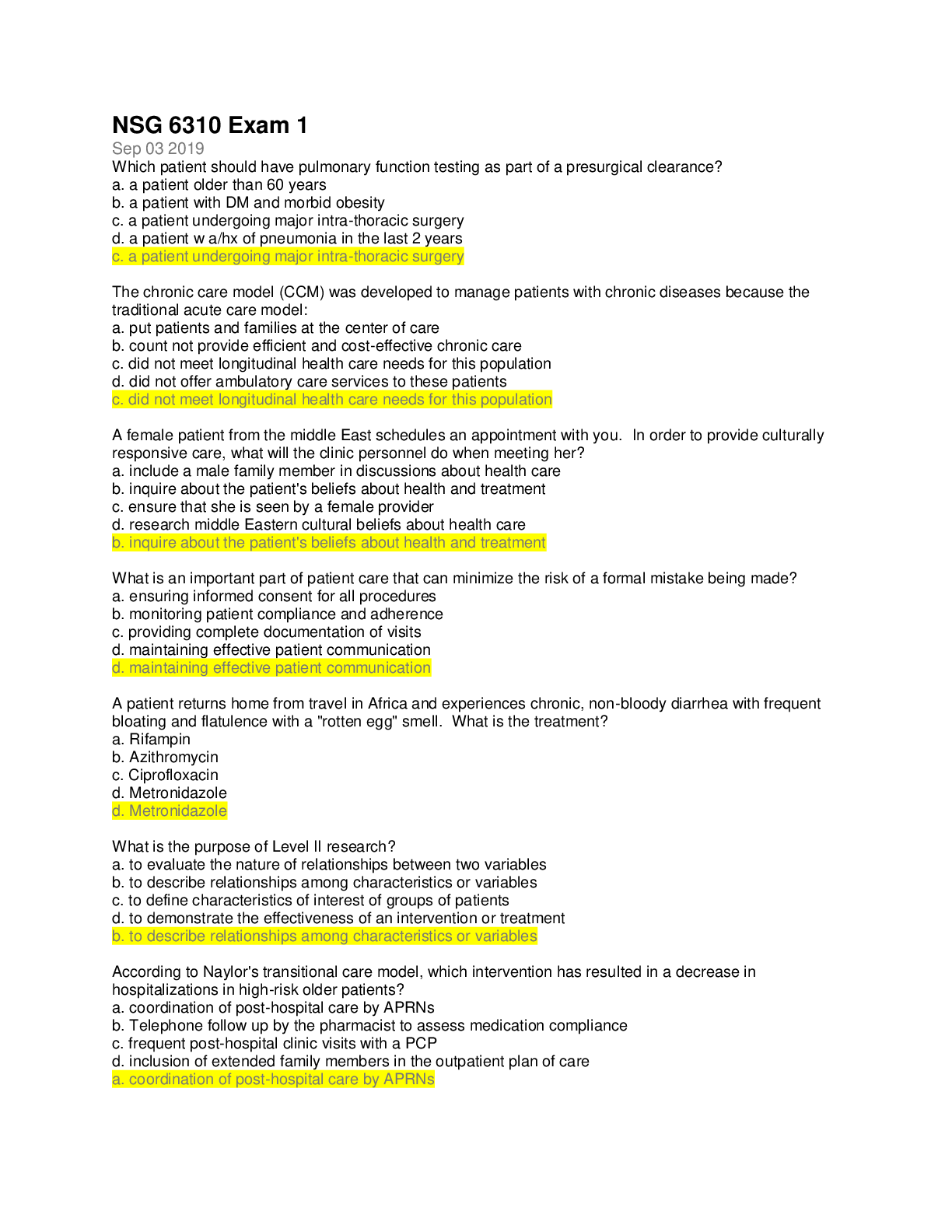
Reviews( 4 )

by KING STUDY · 2 years ago

by KING STUDY · 2 years ago

by KING STUDY · 2 years ago

by KING STUDY · 2 years ago
Document information
Connected school, study & course
About the document
Uploaded On
Sep 11, 2019
Number of pages
21
Written in
Additional information
This document has been written for:
Uploaded
Sep 11, 2019
Downloads
1
Views
134

